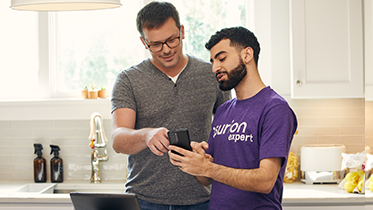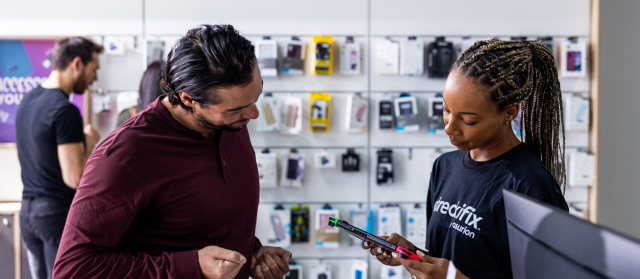Unboxing a new computer and peeling away the screen’s protective film is exciting. But what are you supposed to do with your old one?
There are several responsible ways to get rid of an old computer. We'll break them down so you can make the decision that's right for you.
Can I just throw my old computer away?
It may seem easier to toss it in the bin with last week's leftovers, but computers and other electronic waste, or e-waste, can do serious damage to the environment when thrown in landfills.
Electronic devices, like computers and smartphones, are made of heavy metals—like cadmium, lead, and mercury—that if left in a landfill, can seep into the earth and contaminate the groundwater. These contaminants then infect local plants and ecosystems, causing long-lasting damage to our communities.
In addition to these harmful metals, electronic equipment also contain small amounts of precious metals like gold, copper, and platinum. These materials are valuable and can be recovered from recycled electronics using special procedures.
Learning how to recycle a computer is a great way to properly dispose of its harmful components and save the reusable ones.
Should I donate my old computer?
Donating your computer is another great way to get rid of an old device while doing some good for your community. If you'd like to donate a computer, talk to your local donation center or library to see if there are any specifications for electronics donations. Some programs won't accept computers that are older or in need of repair because they aren't particularly useful for someone in need.
Is there a trade-in program for old computers?
Another alternative is to return your old device to the manufacturer that made it. Apple® and Samsung® are two companies that have trade-in programs that give you credit towards buying a new device. This is a fantastic way to get rid of an old device while saving some money in the process, but these companies are very particular about the devices they'll accept for trade-in. It can't be too old, and you'll often get a much lower quote if the device is damaged.
Prepare your computer for recycling
If you decide that you'd like to recycle your old computer, you'll need to do some prep work first. Think about all the personal data you have on your computer: years of documents, photos, saved passwords, contact information, and bank account information. Before recycling a computer, selling, or passing down your devices, it's important to remove this personal data so that it doesn't accidentally fall into the wrong hands. This isn't difficult, but it needs to be done safely and effectively to ensure all the data is wiped.
How to wipe personal information from your computer
1. Back up personal files
The first step to safely wiping all personal information from a computer is to create a backup that'll keep all those important photos and documents safe. You can back up your device using an external hard drive or by uploading things to a cloud storage system. Check out our guide to the best cloud storage options for your computer.
2. Drive encryption
Drive or disk encryption is a powerful tool used to protect important data that is kept on computer hard drives. It lets you lock your data with a passcode so that if anyone were to find the hard drive, they wouldn’t be able to access it. Drive encryption might be useful for those who are nervous about recycling a work computer used for classified information.
3. Deauthorize your computer from connected software
Connected accounts and password managers make our lives so much easier by syncing all our devices and saving us time. But when it's time to part with a device, it's important to remove and sign out of these programs and apps to prevent potential identity theft.
If you're using a Mac®, you can find some of these accounts under Settings > Internet Accounts. For online sites or if you're on a PC, you'll have to sign out or deauthorize your computer manually.
4. Delete browsing history
Deleting your internet browsing history is an important step. Many of our most visited websites have saved information about our preferences and you'll want to prevent any traces of personal information from staying on the device.
To delete your browsing history, go to your browser's settings and select History. From there, select the option to Clear browsing data. Depending on which browser you're using, you should be given options to clear browsing history, cookies, and cached data—we recommend selecting all three to clear your browser entirely.
5. Uninstall programs
The last step before wiping the device permanently is to uninstall your personal programs from the device. This will ensure that any related files or information in these programs will be wiped from the device. You'll want to uninstall programs individually using the applications list in Windows or by managing your storage on a Mac.
6. Wipe your hard drive
The last step is the actual wiping of the hard drive, also called performing a factory reset. Each computer will have a different process for finishing this step, but these guides for how to wipe a MacBook® and how to factory reset a PC offer step-by-step instructions.
It's important to remember to back up your personal data before finishing this step, as there'll be nothing on the device after you wipe it. Once you’re done, you can start the process of recycling your old computer.
Locate a computer recycling facility
After you've wiped your old computer of any personal data or information, the next step is finding a recycling center. Your options will vary based on your location, but here are some great resources to start learning how to recycle a computer:
How to find a computer recycling program near you
Online resources like Earth911 are great starting points when looking for old computer disposal options in your area.
Participating uBreakiFix® by Asurion stores also accept old computers and other electronics to be recycled. We partner with Samsung to ensure that all devices are properly recycled.
Many electronics stores like Staples and Best Buy have recycling organizations, but you should call your local location to ensure that they are accepting drop-offs. It's also a good idea to check with the recycling program about the computer's battery. Some programs require the removal of the battery prior to drop-off; otherwise, they won't accept it.




